![]()
![]()
![]()
Use LEFT and RIGHT arrow keys to navigate between flashcards;
Use UP and DOWN arrow keys to flip the card;
H to show hint;
A reads text to speech;
72 Cards in this Set
- Front
- Back
|
Ovulation |
Typically around day 14 - Release of the egg, fallopian tube gets ready to catch the egg |
|
|
Luteal Phase |
Days 15-28 Just after ovulation tot he onset of menstruation corpus luteum happens |
|
|
Corpus Luteum |
A ruptured follicle becomes a dense network of blood capillaries and yellow lipid (scar tissue). Eventually becomes a new follicle and surrounds a new egg |
|
|
Folliculogenesis |
changes in the follicle surrounding an egg during oogenesis |
|
|
Folliculogenesis - before birth |
1st phase - primordial follicles: primary oocyte (immature egg) surrounded by cells - appears long before birth - no change until adolescence |
|
|
Folliculogenesis - adolescence (primary follicles) |
Everything gets larger primary follicles: larger oocyte and larger single layer of cells |
|
|
Folliculogenesis - adolescence (secondary follicles) |
- larger oocyte and larger single layer of cells - developing layers of cells (stratified = multiple layers) - secrete a gel around the oocyte (zone pellucida) |
|
|
Folliculogenesis - adolescence (tertiary follicles) |
cells secrete follicular fluid forming a fluid cavity around the oocyte (antrum) - antrum - another layer of jelly like matrix |
|
|
Folliculogenesis - adolescence (mature follicles) |
during ovulation the oocyte breaks away becoming free floating - egg gets released |
|
|
Menstrual Cycle |
- Occurs at the same time as the ovarian cycle - build up, break down and discharge of the endometrium |
|
|
4 Phases of the Menstrual Cycle |
1. Proliferative 2. Secretory 3. Premenstrual 4. Menstrual |
|
|
Prolferative |
(Day 5 or 6 to Day 14) - layer of endometrial tissue lost in last menstrual cycle is rebuilt
|
|
|
Secratory |
(Day 15 to Day 26) - Endometrium thickens even more - Right after Ovulation (day 14) - Ready for embryonic development - surge in release of hormones |
|
|
Premenstrual |
(Days 27 and 28) - last 2 days - Endometrial starts to break down - Corpus Luteum (degenerated follicle) starts to break down |
|
|
Menstrual |
(Days 1 through 5 or 6) - Menstrual fluid is formed from breakdown of endometrium - discharged fromt he vagina - First day of discharge marks day 1 of a new cycle |
|
|
Name the 4 Female Hormones |
1. FSH - Follicle Stimulating Hormone 2. Luteinizing Hormone 3. Estrogen 4. Progesterone |
|
|
Cycle of Hormones (Steps 1 and 2)
|
1. increase in FSH and LH (secreted from the brain) 2. FSH stimulates the growth of an ovarian follicle - as the maturing follicle grows, it secretes estrogen in increasing amounts |
|
|
Cycle of Hormones (Steps 3 and 4) |
3. Estrogen levels peak after about 12 days 4. ^ which causes a sudden surge in FSH and LH - this stimulates ovulation |
|
|
Cycle of Hormones (Steps 5 and 6) |
5. Ovulation (developing follicle bursts and releases an egg) 6. Rising levels of estrogen and progesterone thinker the endometrium to get ready for possible fertilization - prevents a second follicle from developing |
|
|
Cycle of Hormones (Steps 7) |
Once estrogen and progesterone levels fall below a critical level the endometrium begins to shed |
|
|
Contraception: and it's 4 types |
deliberate prevention of pregnancy 1. Behavioral - Temprary (Rhythm Method) and complete abstinence 2. Permanent - Vasectomy and Tubal Ligation 3. Barrier Methods - (physically prevent union of sperm and egg) Diaphragm, Spermicides, and condems 4. Hormonal - birth control pills |
|
|
Abstinence |
Complete - avoiding intercorse (only total effective form of abstinence) Temporary - avoiding intercorse during ovulation (rhythm method or natural family planning) *most unreliable option because sperm live for long periods of time*
|
|
|
Tubal Litigation |
A doctor removes a short section of each fallopian tube, often tying to ligating the ends and thereby blocking the route of the sperm to the egg (permanent) |
|
|
Vasectomy |
Doctor cuts a section out of each vas deferens to prevent sperm from reaching urethra (permanent) |
|
|
Barrier Methods |
condoms diaphragm - covers the cervix spermicides - kills the sperm |
|
|
Birth Control Pills |
- prevention of the release of gametes - comes in a variety of pills, shots, patches - contains carrying amounts of hormones - ceases ovulation - fools the body that pregnancy has occurred |
|
|
Morning After Pill |
Prevents fertilization or implantation after intercorse has occurred |
|
|
Life Cycle |
carrying genetics from one generation to the next |
|
|
Gametogenesis |
production of gametes - egg and sperm |
|
|
Haploid Cells |
(n) = 23 chromosomes only 1 set of chromosomes
|
|
|
Diploid Cells |
(2n) = 46 chromosomes 2 sets of (n) chromosomes in each cell - one set inherited from each parent - fertilization of an egg by sperm |
|
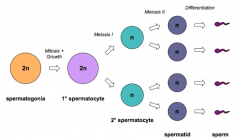
|
Spermatogenesis - formation of sperm cells - start with an immature sperm cell (2n) goes through copy (Meiosis 1) and division (Meiosis 2) - 1 sperm cell = 4 sperm |
|
|
A male starts with a sperm cell containing 46 chromosomes, how many sperm does he end up with and how many chromosomes are in each sperm? |
He ends with 4 sperm each containing 23 chromosomes |
|
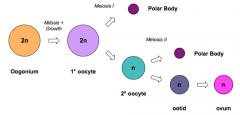
|
Oogenesis - development of mature eggs - ova - 1 cell gives 1 egg - starts with 2n and ends with 1 egg (n) - polar body = extra chromosome |
|
|
Fertilization |
Haploid (n) sperm cell from father fuses with haploid (n) egg cell from mother zygote = fertilized egg - diploid (2n) |
|
|
Meiosis |
- Method in which egg and sperm are produced - Process of cell division that produces haploid gametes in diploid organisms |
|
|
Difference between Mitosis and Meiosis |
1. Meiosis - # of chromosomes is reduced by half (meiosis 1 and 2 produces 4 daughter cells) - produces n cells; Mitosis produces 2n cells 2. exchange of genetic material - crossing over (genetic shuffling) 3. strictly for producing egg and sperm
|
|
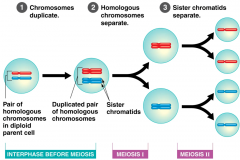
|
Meiosis - only sex organs XX > XX > XX + XX > X(23) + X(23) + X(23) + X(23) XX
1 diploid (2n) cell to 4 haploid (n) cells
|
|
|
Mitosis |
- provides for growth, tissue repair, and asexual reproduction (every other cell in the body) - produces daughter cells genetically identical to parent cells |
|
|
Homologous Chromasomes |

2 chromosomes that make up a matched pair in a diploid cell (one from mom and one from dad) |
|
|
Sister Chromatid |
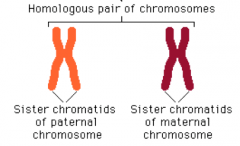
one of the two identical parts of a duplicated chromosome (when copying occurs) |
|
|
Phases of Meiosis |
- Interphase - Meiosis l - Homologous chromosomes separate (Prophase l, Metaphase l, Anaphase l, Telophase l, and Cytokinesis) - Meiosis ll - Sister chromatids separate (Prophase ll, Metaphase ll, Anaphase ll, Telophase ll, and Cytokinesis) |
|
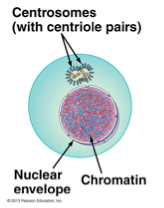
Which phase? |
Meiosis: Interphase - chromosomes duplicate - each chromosome then consists of two identical sister chromatids - NO cellular division, ONLY the copy of DNA |
|
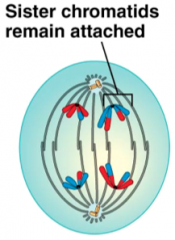
Which phase? |
Meiosis: Anaphase l - the attachment of homogenous chromosomes will be pulled apart - the sister chromatids go in pairs (different than mitosis) - chromosomes migrate towards the poles |
|
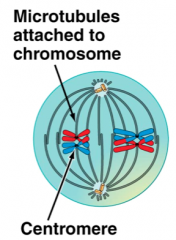
Which phase? |
Meiosis: Metaphase l - Homologous pairs are aligned down the middle - sister chromatids of each chromosome are attached to their centromeres - preparing themselves to be pulled apart |
|
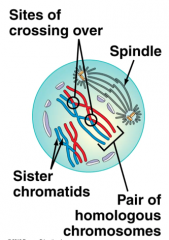
Which phase? |
Meiosis: Prophase l - copied DNA are in pairs, held by proteins - results in 4 chromatids - crossing over occurs (rearranging genetic info) - spindle microtubules form - homogenous chromosomes move toward center of cell
|
|
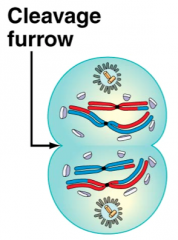
Which phase(s)? |
Meiosis: Telophase l and Cytokinesis Telophase l - chromosomes arrive at the poles (ea. pole has a haploid set of chromosome set) - Nuclei form Cytokinesis - splitting of the cytoplasm to form two haploid daughter cells (creating the cleavage furrow) |
|
|
Meiosis ll |
- essentially the same as Mitosis - important difference: meiosis ll starts with a haploid cell that does not undergo chromosomal duplication |
|
|
What is a Meiosis Error? |
An accident during Meiosis that could alter chromosome number |
|

Nondisjunction |
members of a chromosome pair fail to separate at anaphase - affects someone's gender - can occur during Meiosis l or ll - gametes with abnormal numbers (instead of 46, they may have 45 or 47) |
|
|
Meiosis Error: Monosomy |
absence of one member of a pair of chromosomes (45) |
|
|
Meiosis Error: Trisomy |
extra chromosome 3 chromosomes, rather than the usual pair (47) |
|
|
Meiosis Error: Sex Chromosomes |
chromosomes that determine a person's sex XX = female and XY = male (last pair - 23) |
|
|
Meiosis Error: Autosomal Chromosomes |
non-sex chromosomes eye color, hair color, nose shape, etc. (first 22 pairs) |
|
|
3 Types of Chromosome Anomalies |
1. Down Syndrome 2. Klinefelter 3. Turner Syndrome |
|
|
Down Syndrome |
Trisomy 21 (additional chromosome) - Characteristics: facial (flat face and nose, fold of skin near eye; short stature; heart defects; carrying degree of mental retardation; usually a shorter lifespan
|
|
|
Klinefelter |
- abnormal #of sex chromosomes: (extra X chromosome in males - XXY) - Characteristics: male sex organs; normal intelligence; testes abnormally small; sterile; breast enlargements, feminine body contours. - symptoms can be reduced with testosterone |
|
|
Other sex anomalies |
XYY - No syndrome, Normal male XXX - No syndrome, Normal female |
|
|
Turner Syndrome |
- Females who lack an X chromosome (XY, XO, or X) - Characteristics: short stature; web of skin extending on the sides of the neck; normal intelligence; sterile; poor development of breast and other secondary sex characteristics - symptoms can be treated with estrogen |
|
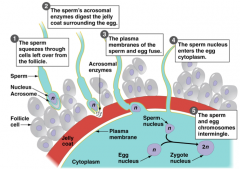
Fertilization |
Union of sperm and egg to form a zygote |
|
|
Embryonic Development |
We started as a single cell and become trillions of cells witch organized themselves and became specialized. and we developed into a complete organism |
|
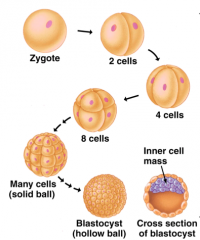
|
Cleavage: series of rapid cell divisions that produce a multicellular ball - DNA replication, mitosis, cytokinesis - embryo size does not change rather there is twice as many cells each with its own nucleus - cleavage continues as the embryo moves down the fallopian tube - a central cavity starts to form in the embryo |
|
|
Embryo vs. Fetus |
Embryo: up to 8 weeks of development Fetus: 8 weeks until birth |
|
|
Morula |
ball of more than 16 cells |
|
|
Blastocyst |
fluid filled hollow ball of about 100 cells - after 6 or 7 days after fertilization the embryo has reached the uterus |
|
|
Grastrulation |
2nd stage of development by 9 days after conception |
|
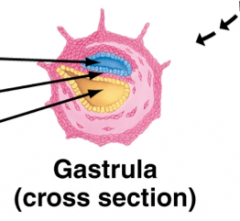
Gastrula |
cells of the embryo begin an organized migration - embryo with 3 main layers - ectoderm - mesoderm - endoderm |
|
|
Ectoderm |
- develops into nervous system and outer layer of skin |
|
|
Mesoderm |
- middle layer - gives rise to most other organs and tissues - heart, kidneys, and muscles |
|
|
Endroderm |
- develops into inner most layer of digestive system and major organs - liver, pancreas, and thyroid |
|
|
Implantation |
a fertilized egg makes its way into the uterus where it will attach itself to the lining for development (a gastrula implanting itself in the uterus) |
|
|
Gestation |
period of pregnancy, carrying the developing young in the female reproduction tract (40 weeks) |

